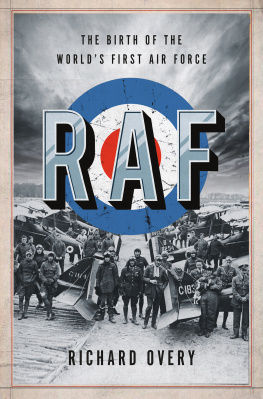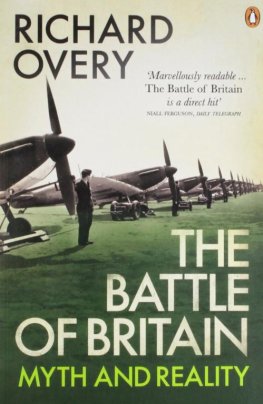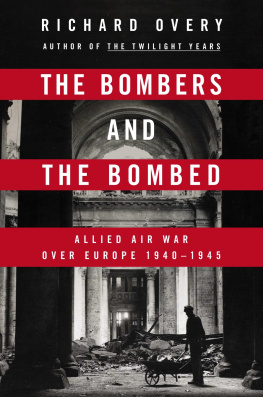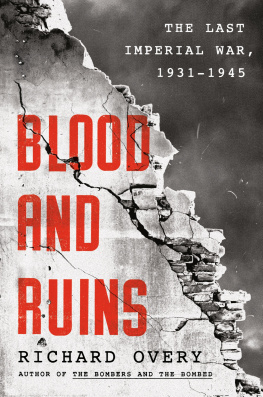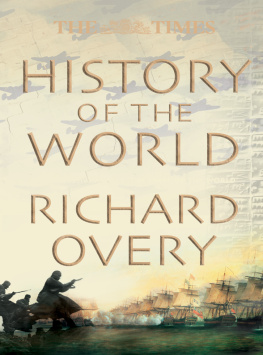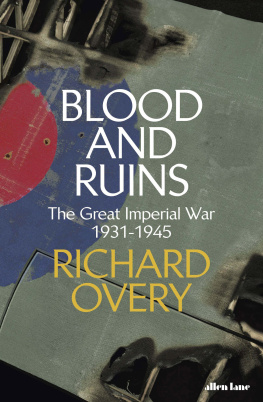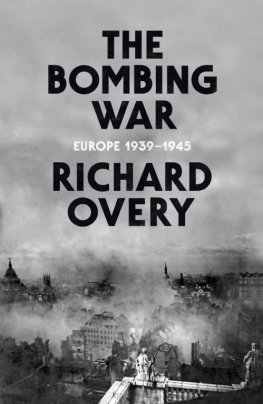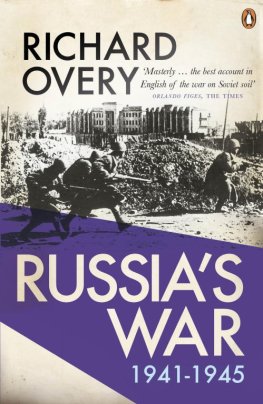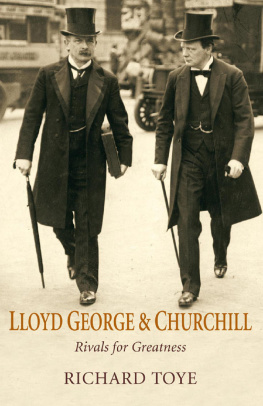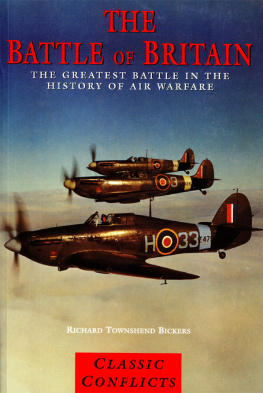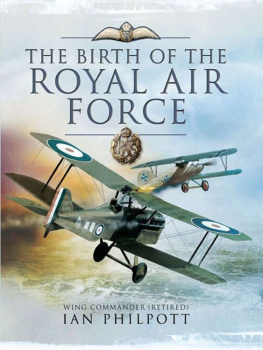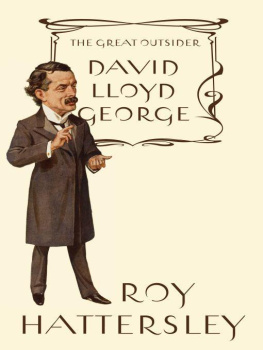
RAF
The Birth of the Worlds First Air Force
Richard Overy

Copyright 2018 by Richard Overy
First American Edition 2018
First published in Great Britain under the title The Birth of the RAF, 1918: The Worlds First Air Force
All rights reserved
For information about permission to reproduce selections from this book, write to Permissions, W. W. Norton & Company, Inc., 500 Fifth Avenue,
New York, NY 10110
For information about special discounts for bulk purchases, please contact W. W. Norton Special Sales at specialsales@wwnorton.com or 800-233-4830
JACKET DESIGN: ERIC FUENTECILLA
JACKET IMAGES: EVENING STANDARD / GETTY IMAGES; (SKY) NEJRON PHOTO / SHUTTERSTOCK
ISBN 978-0-393-65229-1
ISBN 978-0-393-65230-7 (e-book)
W. W. Norton & Company, Inc., 500 Fifth Avenue, New York, N.Y. 10110
www.wwnorton.com
W. W. Norton & Company Ltd., 15 Carlisle Street, London W1D 3BS
CONTENTS
The Royal Air Force was formally activated on 1 April 1918, April Fools Day. It was an inauspicious date on which to launch the worlds first independent air force, and there were hesitations about choosing it. Perhaps the army and the Royal Navy, both for their own reasons wary of the fledgling service, quietly approved the choice of date, hoping that a separate air force would soon prove itself a joke. They certainly both hoped that the RAF and the new Air Ministry it served would not last beyond the end of the war. In this they were soon to be disabused. The RAF survived victory in 1918 and has survived regular calls for its dissolution since, and now celebrates an uninterrupted hundred years.
The birth of the RAF was surrounded by argument and controversy. There already were two air services fighting Britains aerial contribution to the First World War: the Royal Naval Air Service and the armys Royal Flying Corps. The establishment of an entirely new branch of the armed forces was a political decision, prompted by the German air attacks on London in 1917, not a decision dictated by military necessity. The politicians wanted a force to defend the home front against the novel menace of bombing, amidst fears that the staying power of the population might be strained to breaking point by the raids. From the politicians viewpoint, the air defence of Great Britain was one of the principal charges on the new force, and it is the defence of the home islands twenty-two years later in the Battle of Britain that is still remembered as the RAF s finest hour. The reality of the past hundred years has been rather different. The RAF has principally served overseas and for most of the century was a force dedicated to bombing and to ground support for the other services. This future was anticipated in the final seven months of combat in 1918 when the RAF , building on the legacy of its two predecessors, contributed substantially to the air support of Allied armies in Western Europe and the Middle East, and organized the Independent Force (independent of the front line) for the long-range bombing of German industrial towns. By the time of the Armistice in November 1918, the shape of RAF doctrine was already in firm outline, even if its future as a separate force was thrown into doubt once the fighting was over.
The birth pangs of the RAF are the subject here. Founding a new service in the midst of a bitterly contested conflict raised all kinds of practical questions which had to be resolved, from the colour of uniforms to the very name itself. The long history of the RAF as an institution was given shape in the earliest days of its existence. There are numerous records to help reconstruct those early days and a wealth of memoir and historical literature to draw on. I am grateful for the help I have received in the archives and libraries I have exploited and for the encouragement of the staff at the RAF Museum at Hendon, where I have been privileged to chair the Research Board. This volume is a small contribution to the wider programme of commemoration in which the museum is engaged. My thanks as ever to my agents, Gill Coleridge and Cara Jones, and to Simon Winder and the team at Penguin, and particular thanks to one of my colleagues on the Research Board, the Head of the Air Historical Branch, Sebastian Cox, for his sound advice on an earlier draft. Needless to say, the views expressed throughout are my own, as are any errors of fact or interpretation that might remain.
Richard Overy,
Exeter and London, 2017
A fixed determination to attack and win will be the surest road to victory.
RFC Training Manual, 1913
In 1908, only five years after the Wright brothers first powered flight in December 1903, the British novelist H. G. Wells published The War in the Air , in which he imagined a near future when aircraft would decide the outcome of modern war. The novels hero, Bert Smallways, watching the destruction of New York by German airships, reflects on Britains vulnerability: the little island in the silver seas was at the end of its immunity.and only ten from the establishment of the Royal Air Force, set up to try to protect Britains vulnerable people from an air menace described so graphically by Wells at the dawn of the air age.
One of the many remarkable consequences of the coming of powered flight was the speed with which the armies and navies of all the major powers sponsored the development of aircraft both dirigibles and aeroplanes for military purposes. The technical development of aircraft in the decade following the Wright brothers was exponential and knowledge of the new invention universal, but for the British people, all but immune to invasion for a millennium, aviation posed a particular strategic threat. This perhaps explains why the evolution of military air power in Britain in the age of the Great War was strongly influenced by public opinion and political pressure and was not solely a result of the military need to respond to innovation. Critics at the time and since have blamed military conservatism for the slow development of organized air power in Britain before 1914 and have assumed that public disquiet, noisily expressed in the popular press, prompted a grudging army and navy to explore the use of aircraft despite harbouring strong prejudices against their use.
The army and navy were, in truth, less narrow-minded than the popular image suggests. The first powered flight in Britain was only made in 1908 by A. V. Roe, who managed a distance of just 60 yards (55 metres). A mere three years later the army began developing a military air arm when the Royal Engineers established an Air Battalion consisting of a company of airships (still considered a major factor for the future of air warfare) and a company of aeroplanes. On 13 April 1912 the King issued a Royal Warrant for a new service, and a month later, on 13 May, the battalion was replaced by the Royal
Both the navy and the army understood that aircraft were likely before long to become assets indispensable to their operations. In view of the fact that aircraft will undoubtedly be used in the next war, wrote the Chief of the Imperial General Staff in 1911, we cannot afford to delay... The army Field Service Regulations published in July 1912 were the first to contain reference to the use of aircraft, and in the 1912 field exercises two airships and fourteen aircraft were used for reconnaissance
It was nevertheless true that the RFC was a considerable way behind the development of aviation elsewhere. In France, Austria and Germany rapid progress had been made in military aeronautics; the small Bulgarian air force was responsible for inventing the first modern aerial bomb; and in 1914 the Russian engineer Igor Sikorsky developed the multi-engine Ilia Muromets Sikorsky Type V aeroplane, the first modern heavy bomber. British services were slower to respond, partly because they did not anticipate a major European war, partly because public and government were fixated on the battleship arms race, and partly because the British army was so much smaller and less politically powerful than its Continental rivals. When war broke out in August 1914, the RNAS possessed only six airships and ninety-three aeroplanes, many of which were unserviceable, and could field only one flying squadron (the word chosen in 1912 to describe the small air units being formed). The RFC arrived in France with the British Expeditionary Force ( BEF ) with just four squadrons totalling approximately sixty aircraft. There were 105 officers and 755 other ranks. The French army put twenty-three squadrons in the field, the German army twenty-nine.
Next page
